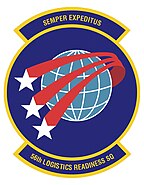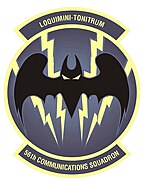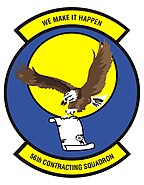| 56th Fighter Wing | |
|---|---|
 56th Wing Shield | |
| Active | 15 January 1941 |
| Country | United States |
| Branch | Air Force |
| Size | 138 F-16 Fighting Falcon |
| Part of | Air Education and Training Command |
| Garrison/HQ | Luke Air Force Base |
| Nickname(s) | Thunderbolts |
| Decorations |
|
| Commanders | |
| Current commander | Brigadier General Jerry D. Harris, Jr. |
| Notable commanders |
Ronald Fogleman George Scratchley Brown Carrol Chandler Joseph Ralston |
The 56th Fighter Wing (56 FW) is a United States Air Force unit assigned to the Air Education and Training Command's Nineteenth Air Force. It is stationed at Luke Air Force Base, Arizona where it also is the host unit.
The 56th FW trains F-16 fighter pilots and maintainers, qualifies instructors, conducts conversion pilot training, and instructs forward air controllers, all while deploying mission-ready combat pilots. The wing is home to nearly 140 F-16 aircraft and 24 squadrons, six of which are F-16 fighter squadrons, making it the largest fighter wing in the Air Force. The 56th Fighter Wing graduated 430 basic, instructor, and upgrade F-16 pilots and 650 crew chiefs in Fiscal Year 2010. The wing also trains personnel and maintains resources to meet contingency and wartime tasking.
The wing is one of the most highly decorated aviation units in history, traces its history to the 56th Fighter Group which was a World War II P-47 Thunderbolt fighter group. Assigned to the Eighth Air Force in England, the 56th FG flew its first combat missions of World War II on 13 April 1943. During its two-year involvement in the air war in Europe, the group damaged or destroyed 1,598.5 enemy aircraft, while losing only 25 fighters in air-to-air combat. The 56th FG also produced 39 fighter aces.
The 56th Fighter Wing was activated on 15 August 1947. The wing's mission was air defense. The unit wrote another chapter in aviation history 14 July 1948, when its F-80 Shooting Stars made the first ever west-to-east crossing of the Atlantic by military jets. The flight was a month after the Soviets set up their blockade of Berlin, and put the Soviets on notice that this nation had the capability to deploy a large package of military aircraft across the Atlantic in minimum time. The 56th was reassigned to Thailand on 16 March 1967. While deployed to Southeast Asia, the 56th not only supported but also conducted unconventional combat operations against an opposing armed enemy force in Laos.
The commander of the 56th Fighter Wing since September 2010 is Brig. Gen. Jerry D. Harris, Jr.. The Command Chief Master Sergeant is Chief Master Sgt. David R. Staton.
Units[]
The 56th Fighter Wing consists of:
|
|
History[]

F-16 from the 56th Fighter Wing

North American F-86F Sabre jet

A-26 light tactical bomber, the model flown by the 609th Special Operations Squadron

Douglas A-1E and H Skyraiders of the 1st and 602nd Special Operations Squadrons at Nakhon Phanom RTAF

McDonnell F-4D-29-MC Phantom Serial 66-0244 of the 61st TFS.

General Dynamics F-16A Block 10B Fighting Falcon Serial 79-0397 of the 61st TFS.
- For additional history and lineage, see 56th Operations Group
The 56th Fighter Wing was activated 1 May 1946 at Selfridge AAF, Michigan as part of the Strategic Air Command's Fifteenth Air Force. It included the 61st, 62d and 63d Fighter Squadrons flying Lockheed P-80 Shooting Stars.
In July and August 1948, the wing pioneered the first west-to-east jet fighter transatlantic crossing along the northern air route from the United States to Europe, involving 16 of its F-80's. The flight proceeded to Fürstenfeldbruck Air Base, Germany, by way of Maine, Labrador, Greenland, Iceland and Scotland. Although the operation was not connected with the Berlin Airlift, it did focus world attention on the U.S. Air Force's ability to rapidly deploy jet fighters during a crisis.
Air Defense Command[]
The wing was transferred from Strategic Air Command to the Continental Air Command's 10th Air Force 1 December 1948 and the mission of the wing's tactical units was shifted to air defense. The unit was redesignated as the 56th Fighter Interceptor Wing on 20 January 1950. Its 61st, 62d and 63d Fighter-Interceptor Squadrons converted from the F-80 Shooting Star to the North American F-86 Sabrejet in April 1950.
The wing, with the exception of the four tactical squadrons, was inactivated 6 February 1952. The tactical squadrons were reassigned to the new air defense wings as part of a general reorganization of the Air Defense Command.
Almost nine years later, having been redesignated the 56th Fighter Wing (Air Defense), the wing was reactivated at K.I. Sawyer AFB, Michigan again with an air defense mission. The wing controlled a single tactical unit, the 62d Fighter-Interceptor Squadron, flying the McDonnell F-101 Voodoo.
From 1 February 1961 to 1 October 1963, the wing was part of the Sault Sainte Marie Air Defense Sector. From 1 October 1963 to 1 January 1964, the wing was an important part of the Duluth Air Defense Sector. Under both sectors, the wing participated in many ADC exercises, tactical evaluations and other air defense operations. The single tactical squadron was placed directly under Duluth Air Defense Sector 16 December 1963, leaving the wing without a tactical mission.
On 1 January 1964, the wing was assigned to SAC and inactivated.
Vietnam War[]
Slightly more than three years later, the wing was once again activated, this time at Nakon Phanom Royal Thai AFB, Thailand. The unit was designated the 56th Air Commando Wing and had a complex combat mission in the war then raging in Southeast Asia (see the Wikipedia article on Nakhon Phanom Royal Thai Air Force Base for more details). Assigned to Thirteenth Air Force, the wing received operational direction from Seventh Air Force in Saigon.
The unit was redesignated the 56th Special Operations Wing in 1968. Attached squadrons of the 56th SOW were:
- 1st Special Operations: (1967–72) (A-1E/G/H/J Tail Code: TC)
- 18th Special Operations: (1971–72) (AC–119)
- 21st Special Operations: (1967–75) (CH-3E, CH-53)
- 22d Special Operations: (1967–75) (A-1E/G/H/J Tail Code: TS)
- 602d Special Operations: (1967–70) (A-1E/H/J Tail Code: TT)
- 606th Special Operations: (1967–71) (U-10D, C-123B, T-28D Tail Code: TO)
- 609th Special Operations: (1967–69) (A-26A/K, T-28D, UC/C-123K Tail Code: TA)
- 460th Reconnaissance: (1970–72) (EC-47N/P)
- 554th Reconnaissance: (1970–72) (QU-22B)
- 23d Tactical Air Support: (1972–75) (O-2A, OV-10)
- 361st Tactical Electronic Warfare: (1972–74) (EC-47)
The wing performed combat in Southeast Asia from April 1967 – August 1973, and combat support until June 1975, employing a wide variety of aircraft to meet specialized missions. Those missions included interdiction, psychological warfare, close air support, search and rescue, forward air control, training Thai and Laotian air forces, and helicopter escort for clandestine insertion and extraction of personnel in Laos and North Vietnam.
During the sieges of Khe Sanh from February – April 1968, and Lima Site 85 from January – March 1968 where it provided close air support. Wing elements participated in the Son Tay Prison raid on 21 November 1970 and continued combat in Vietnam until mid-January 1973, in Laos until 22 February 1973, and in Cambodia until 15 August 1973.
The 56th assisted in Operation Eagle Pull, the evacuation of Phnom Penh on 12 April 1975 and Operation Frequent Wind, the evacuation of Saigon on 29 and 30 April 1975. During the SS Mayagüez rescue operation on 15 May 1975, it provided forward air control and helicopter insertion/extraction support.
Tactical Air Command[]
Upon return to the United States on 30 June 1975, the 56th Tactical Fighter Wing absorbed the resources of the 1st Tactical Fighter Wing and operated MacDill Air Force Base and nearby Avon Park Range, Florida. The 56th assumed the F-4E aircraft of the reassigned 1st TFW. Operational squadrons of the wing were:
- 61st Tactical Fighter Squadron (yellow tail stripe)
- 62d Tactical Fighter Squadron (blue tail stripe)
- 63d Tactical Fighter Squadron (red tail stripe)
- 13th Tactical Fighter Squadron (white tail stripe)
- 72d Tactical Fighter Squadron (black tail stripe)
(F-16A/B/C/D Activated 1 July 1981, inactivated 19 June 1992)
The Tail code of the 56th at MacDill was "MC".
The wing conducted F-4D/E replacement training for pilots, weapon systems officers, and maintenance personnel from July 1975 - July 1982. It was equipped with UH-1P helicopters from 1976 to 1987, to support Avon Range logistics needs, search and rescue efforts, and humanitarian missions.
With conversion to F-16A/B aircraft from 1980 - 1982 the 56th became the designated unit for transitioning USAF and select allied nation pilots into the new fighter, while continuing to augment NORAD's air defense forces in the southeastern US. The wing provided logistic support to US Central Command beginning in 1983 and to US Special Operations Command after 1986. It upgraded to F-16C/D aircraft from 1988 to 1990, providing support personnel and equipment to units in Southwest Asia from August 1990 - March 1991.
Air Education and Training Command[]

Taiwanese Air Force F-16As 6610 (93-0711) and 6620 (93-0721) in USAF markings flying in formation as part of the 21st Fighter Squadron.
The end of the Cold War led to the BRAC commissions, and the downsizing of the Air Force to a smaller organization. By 1990, it was believed that the Air Force had five more tactical bases than needed to support the number of fighter aircraft in the revised DoD Force Structure Plan. In evaluating Air Force tactical fighter bases it was decided first to close MacDill AFB in 1993, although under political pressure later it was realigned to a new mission.
The 56th Fighter Wing, due to its seniority and historical heritage, would remain active. The wing was moved administratively to Luke AFB, Arizona on 1 April 1944, assuming the assets of the 58th Fighter Wing. The inherited 311th FS, 312th FS and 314th FS, all on F-16C/Ds at Luke, were also inactivated and replaced by the 61st, 62d and 63d FS which had relocated from the 56th FW from MacDill in name-only re-designations. With Luke now earmarked as the sole active duty USAF F-16 training base, the 56th was re-designated the 56th Fighter Wing When the wing moved to Luke AFB, the F-15C/D Eagle air defence training previously conducted by the 58th was moved Tyndall AFB Florida, where the Air Combat Command Air Defense mission was being reorganized under First Air Force. The resident Luke F-15E Strike Eagle squadron training at Luke was to cease later in 2004 with the 461st and 550th Fighter Squadrons being inactivated and their assets transferred to the 4th Fighter Wing at Seymour-Johnson AFB, North Carolina. The 56th Fighter Wing then increased to an allocation of seven F-16 squadrons with the relocation of the 308th and 309th Fighter Squadrons from Hurricane Andrew battered Homestead AFB, Florida to join the 61st, 62nd, 63rd, 310th and 425th Fighter Squadrons. The 425th FS, being a joint USAF-Republic of Singapore Air Force squadron providing advanced weapons and tactics continuation training for RSAF F-16 pilots,
The line up of eight squadrons was completed in 1997 with the establishment of the 21st Fighter Squadron to train Taiwanese Air Force pilots. BRAC 2005, reduced the number of F-16 training squadrons to six, with the inactivation of the 63d FS on 22 May 2009 and 61st FS on 27 August 2010, reducing its primary aircraft authorization (PAA) from 201 to 138 aircraft. The Secretary of the Air Force announced in July 2011 that two of the 56th's F-16 squadrons are projected to move to Holloman Air Force Base, New Mexico, in 2013 and 2014, redeploying more than 1,000 personnel and 56 aircraft, but remaining assigned to the 56th FW.
Lineage[]
- Established as 56th Fighter Wing on 28 July 1947
- Organized on 15 August 1947
- Redesignated 56th Fighter-Interceptor Wing on 20 January 1950
- Inactivated on 6 February 1952
- Redesignated 56th Fighter Wing (Air Defense), and activated, on 28 December 1960
- Organized on 1 February 1961
- Discontinued, and inactivated, on 1 January 1964
- Redesignated 56th Air Commando Wing, and activated, on 16 March 1967
- Organized on 8 April 1967
- Redesignated: 56th Special Operations Wing on 1 August 1968
- Redesignated: 56th Tactical Fighter Wing on 30 June 1975
- Redesignated: 56th Tactical Training Wing on 1 October 1981
- Redesignated: 56th Fighter Wing on 1 October 1991.
Assignments[]
|
|
Components[]
- 56th Fighter (later, 56th Fighter-Interceptor, 56th Operations) Group: 15 August 1947 – 6 February 1952; 1 November 1991 – 4 January 1994; 1 April 1994–present
- 1st Air Commando (later, 1st Special Operations) Squadron: 20 December 1967 – 15 December 1972
- 13th Tactical Fighter Training Squadron: 15 January 1976 – 1 July 1982
- 18th Special Operations Squadron: 25 August 1971 – 31 December 1972
- 21st Helicopter (later, 21st Special Operations) Squadron: 27 November 1967 – 30 June 1975
- 22d Special Operations Squadron: 25 October 1968 – 30 September 1970
- 23d Tactical Air Support Squadron: 15 March 1972 – 30 June 1975
- 61st (later, 61st Tactical Fighter Training) Squadron: 30 June 1975 – 1 November 1991
- 62d Tactical Fighter (later, 62d Tactical Fighter Training) Squadron: 1 February 1961 – 16 December 1963; 30 June 1975 – 1 November 1991
- 63d Tactical Fighter (later, 63d Tactical Fighter Training) Squadron: 30 June 1975 – 1 November 1991
- 72d Tactical Fighter Training Squadron: 1 July 1982 – 1 November 1991
- 97th Fighter-Interceptor Squadron: attached 1 December 1950 – 20 May 1951
- 361st Tactical Electronic Warfare Squadron: 1 September 1972 – 30 June 1974
- 554th Reconnaissance Squadron: 15 December 1970 – 30 September 1972
- 602d Fighter: 8 April 1967 – 31 December 1970
- 606th Air Commando Squadron: 8 April 1967 – 15 June 1971
- 609th Air Commando Squadron: 15 September 1967 – 1 December 1969
- 4501st Tactical Fighter Replacement Squadron: 30 June 1975 – 15 January 1976.
Stations[]
- Selfridge Field (later, AFB), Michigan, 15 August 1947 – 6 February 1952
- K.I. Sawyer AFB, Michigan, 1 February 1961 – 1 January 1964
- Nakhon Phanom RTAFB, Thailand, 8 April 1967 – 30 June 1975
- MacDill AFB, Florida, 30 June 1975 – 31 March 1994
- Luke AFB, Arizona, 1 April 1994–present
Unit emblems[]
References[]
This article incorporates public domain material from the Air Force Historical Research Agency website http://www.afhra.af.mil/.
- Freeman, Roger A. (1978) Airfields of the Eighth: Then and Now 1994. After the Battle ISBN 0-900913-09-6
- Glasser, Jeffrey D. (1998). The Secret Vietnam War: The United States Air Force in Thailand, 1961-1975. McFarland & Company. ISBN 0-7864-0084-6.
- Maurer, Maurer (1983). Air Force Combat Units Of World War II. Maxwell AFB, Alabama: Office of Air Force History. ISBN 0-89201-092-4.
- Martin, Patrick (1994). Tail Code: The Complete History of USAF Tactical Aircraft Tail Code Markings. Schiffer Military Aviation History. ISBN 0-88740-513-4.
- Ravenstein, Charles A. (1984). Air Force Combat Wings Lineage and Honors Histories 1947-1977. Maxwell AFB, Alabama: Office of Air Force History. ISBN 0-912799-12-9.
- [1] Air Force Historical Research Agency, 56th Fighter Wing
- [2] Air Force Historical Research Agency, 56th Operations Group
- [3] mighty8thaf.preller.us Boxted
- [4] 56th Fighter Group on www.littlefriends.co.uk
- [5] USAAS-USAAC-USAAF-USAF Aircraft Serial Numbers—1908 to present
- [6] www.armyairforces.com
External links[]
| |||||||||||||||||||||||||||||||||||||||||||||||||||||||||||||||||||||||||||||||||||||||||
The original article can be found at 56th Fighter Wing and the edit history here.












